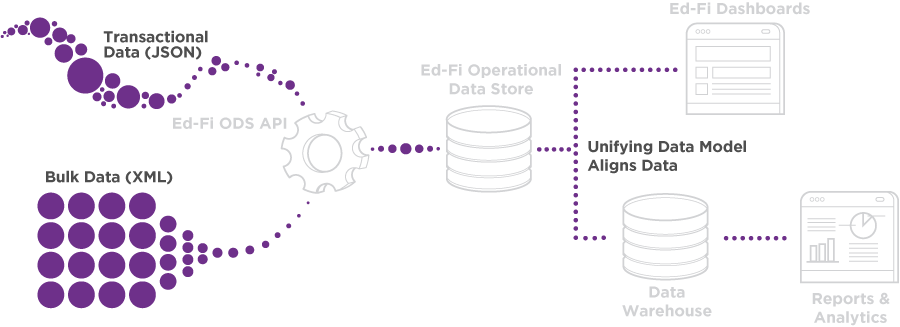This version of the Ed-Fi Data Standard is no longer supported. See the Ed-Fi Technology Version Index for a link to the latest version.
Getting Started - Overview
Overview
The demands on our K–12 educational institutions have never been more pressing. Stagnant test scores, alarming dropout rates, and deep concerns about the next generation’s ability to compete in a global economy have forced state agencies and local school districts to search for more effective ways to improve student outcomes.
Many districts have implemented information systems to capture student data that support state and federal accountability reporting needs. Unfortunately, most of these systems are unable to share information and provide only partial insight into what has already happened in a student’s career. As a result, educators lack access to the consolidated, up-to-date information needed to have a real impact on the academic performance of their students. The Ed-Fi Data Standard facilitates the sharing of information between disparate systems.
The Ed-Fi Data Standard in Context
The Ed-Fi Data Standard supports systems that integrate and organize raw education data and information from a broad range of data sources so it can be sifted and analyzed, thus empowering educators with real-time, actionable information. With systems powered by the Ed-Fi Data Standard, educators are equipped with the information they need to understand the individual needs of students and prepare to address those needs. Plus, on-demand access means that action plans for students can be monitored and refined throughout the school year.
The technology in state, district, and school environments consist of disparate components like transactional information systems, databases, data warehouses, reporting systems, etc. — all of which must exchange information. The Ed-Fi Data Standard provides a vehicle for education data interchange and a foundation for populating an Ed-Fi ODS or other data system. The figure below shows a conceptual overview of where the Ed-Fi Data Standard fits in a typical technology environment.

Conceptual view of an education technology solution
The Ed-Fi Data Standard v2.0 aligns with Version 5.0 of the Common Education Data Standards (CEDS)1 developed by the National Center for Education Statistics (NCES).2 The Ed-Fi Alliance works closely with NCES to support the CEDS effort. Ed-Fi Alliance team members actively participate in CEDS technical and stakeholder groups.
Most important, the Ed-Fi Data Standard v2.0 can be used by any school, school district, or state education agency today. The specific components that make up the Ed-Fi Data Standard are discussed in the following section.
Components of the Ed-Fi Data Standard
The Ed-Fi Data Standard includes the following components:
- Unifying Data Model (UDM)
- XML Data Exchange Framework
- REST API Design & Implementation Guidelines

Conceptual overview of the Ed-Fi Data Standard components
Unifying Data Model
The foundation of the Ed-Fi Data Standard is a Unifying Data Model (UDM), which is an enterprise data model of commonly exchanged and shared K–12 education data. The model is expressed in UML, and includes entities that will be easily recognized by people in the education field: students, teachers, assessment results, attendance, and many others. The role of the UDM is to harmonize the information model and data types across all facets of Ed-Fi technology. UML diagrams and entity definitions are published in the Ed-Fi Unifying Data Model documentation.
XML Data Exchange Framework
The Ed-Fi UDM defines the data model for a companion XML data exchange framework expressed as XML Schema Definition (XSD) files. The XSD files support the exchange of student data among disparate source systems, such as gradebook applications, curriculum and lesson planning systems, and benchmark testing and reporting systems. The XSD may be extended to support implementation-specific needs. The Ed-Fi Data Exchange Framework is vendor-neutral and can work with any hardware and software platform.
REST API Design Guidelines
Another component of the Ed-Fi Data Standard is the Ed-Fi REST API Design Guidelines. The Ed-Fi REST API Design Guidelines provide design guidelines for an Ed-Fi representational state transfer (REST) application programming Interface (API). The guidelines describe the properties to which an API specification and related implementation must adhere to in order to be considered "Ed-Fi aligned." The Ed-Fi Unifying Data Model provides the basis for the data transferred and manipulated by an Ed-Fi REST API implementation. For more information on the Ed-Fi REST API, refer to the Ed-Fi API Design & Implementation Guidelines.
1 For more information about the Common Education Data Standards, see http://ceds.ed.gov.
2 For more information on the National Center for Education Statistics, see http://nces.ed.gov.